CASSINI
A Mission to Saturn and Titan

 The CASSINI mission is named after the french astronomer Giovanni Domenico Cassini (1625-1712) who discovered 4 moons of Saturn and the ring system in the 17th century. CASSINI is a joint effort of NASA, ESA and the Italian space agency ASI. It consists of an orbiting spacecraft (CASSINI ORBITER) and a probe (HUYGENS PROBE) which has been delivered to Saturn's moon Titan. The probe is named after the dutch physicist and astronomer Christiaan Huygens (1629-1695).
The CASSINI mission is named after the french astronomer Giovanni Domenico Cassini (1625-1712) who discovered 4 moons of Saturn and the ring system in the 17th century. CASSINI is a joint effort of NASA, ESA and the Italian space agency ASI. It consists of an orbiting spacecraft (CASSINI ORBITER) and a probe (HUYGENS PROBE) which has been delivered to Saturn's moon Titan. The probe is named after the dutch physicist and astronomer Christiaan Huygens (1629-1695).
Saturn - The jewel of the solar system
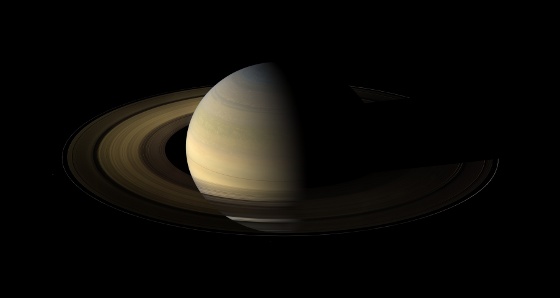
(picture by NASA)
Saturn in equinox
During equinox the Sun shines directly on the equator of a planet. For Saturn this means that the rings cast almost no shadow and can barely be seen from Earth since we look edge on. Cassini's wide angle camera shot 75 pictures from 20 degrees above the ring plane for this mosaic.
The Launch
Cassini was successfully launched onboard a TITAN IV B rocket from Cape Canaveral on October 15, 1997, 08:43 UT. After a journey of seven years it finally reached Saturn in October, 2004.
(pictures by NASA)
![[Top]](/images/icons/top.gif)
The Journey - CASSINI Trajectory
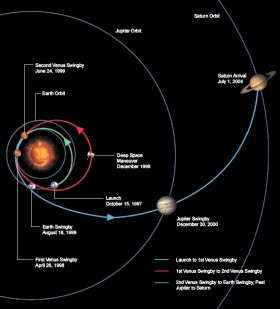
Interplanetary Cruise
Cassini has used the gravity assists from Venus, Earth and Jupiter to reach Saturn. The trajectory through the inner heliosphere is similar to  Galileo.
Galileo.
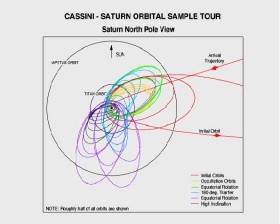
Saturn Orbital Tour
Cassini is the first spacecraft orbiting Saturn. Since 2004 the spacecraft orbits around Saturn. Cassini has already and will continue to extend the knowledge of Saturn's magnetosphere, the rings, the moons and the planet itself.
![[Top]](/images/icons/top.gif)
The Spacecraft
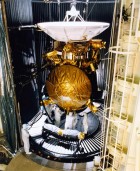
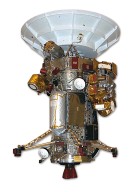 Cassini is the second largest spacecraft after Galileo which was ever launched by NASA. More than half of the total mass is fuel to carry out maneuvers in interplanetary space and in Saturn's magnetosphere.
Cassini is the second largest spacecraft after Galileo which was ever launched by NASA. More than half of the total mass is fuel to carry out maneuvers in interplanetary space and in Saturn's magnetosphere.
- height: 6.7m
- weight: 5630 kg
- diameter: 4m
The Cassini spacecraft. Left picture with the attached Huygens Probe (pictures from JPL Cassini Home page).
![[Top]](/images/icons/top.gif)
Scientific Payload
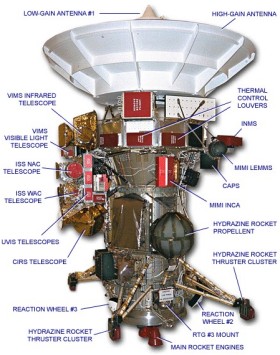
| Cassini Orbiter |
| Titan Radar Mapper (RADAR) |
| Imaging Science Subsystem (ISS) |
| Radio Science Subsystem (RSS) |
| Visual and Infrared Mapping Spectrometer (VIMS) |
| Composite Infrared Spectrometer (CIRS) |
| Cosmic Dust Analyser (CDA) |
| Radio and Plasma Wave System (RPWS) |
| Plasma Spectrometer (CAPS) |
Ultraviolet Imaging Instrument (UVIS:
 HDAC ) HDAC ) |
 Magnetospheric Imaging Instrument (MIMI) Magnetospheric Imaging Instrument (MIMI) |
| Dual Technique Magnetometer (MAG) |
| Ion and Neutral Mass Spectrometer (INMS) |
| |
| Huygens Probe |
|---|
| Aerosol Collector Pyrolyser (ACP) |
 Descent Imager and Spectral Radiometer (DISR) Descent Imager and Spectral Radiometer (DISR) |
| Doppler Wind Experiment (DWE) |
| Gas Chromatograph and Mass Spectrometer (GCMS) |
| Huygens Atmospheric Structure Instrument (HASI) |
| Surface Science Package (SSP) |
![[Top]](/images/icons/top.gif)
MPS contribution
The MPS is contributing to 3 experiments for the Cassini mission. Two of them on the orbiter itself and one on the Huygens probe.
![[Top]](/images/icons/top.gif)
Titan
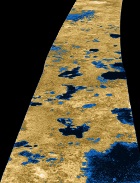 Titan is Saturn's largest moon and orbits the planet at a distance of about 20 Rs. Remarkable is the dense atmosphere that mostly consists of nitrogen (98 %). The Cassini spacecraft has performed more than 60 flybys and revealed some of the mysteries about this interesting moon. It's long known that Titan is the only moon in the solar system that has an atmosphere and scientists speculated about the possibility of liquids on the surface. The thick haze layers preclude the view in visible light. The Cassini Radar image, made in July 2006, gives an impression of how the lakes on Titan look like.
Titan is Saturn's largest moon and orbits the planet at a distance of about 20 Rs. Remarkable is the dense atmosphere that mostly consists of nitrogen (98 %). The Cassini spacecraft has performed more than 60 flybys and revealed some of the mysteries about this interesting moon. It's long known that Titan is the only moon in the solar system that has an atmosphere and scientists speculated about the possibility of liquids on the surface. The thick haze layers preclude the view in visible light. The Cassini Radar image, made in July 2006, gives an impression of how the lakes on Titan look like.
(picture by NASA)
![[Top]](/images/icons/top.gif)
Enceladus
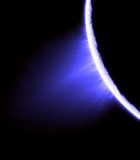
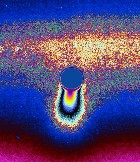 Enceladus is, with a diameter of 504 km, the sixth largest moon of Saturn and orbits the planet at a distance of 3.9 Rs. Covered with water ice, the moons surface has one of the highest albedo in the solar system. Almost all the sunlight is reflected. Since the albedo is a criterion for the age of a body, Enceladus surface should be very young. The left image was taken by Cassini on Nov. 27, 2005 from a distance of 148,000 km. In the south polar region the surface shows several disruptions, the so called Tiger Stripes. They are the origin of the water ice that is streaming into space. Some of the particles form the diffuse E-Ring of Saturn, some particles fall back on the surface that is therefore renewed continuously. Enceladus is losing about 100 kg per second.
Enceladus is, with a diameter of 504 km, the sixth largest moon of Saturn and orbits the planet at a distance of 3.9 Rs. Covered with water ice, the moons surface has one of the highest albedo in the solar system. Almost all the sunlight is reflected. Since the albedo is a criterion for the age of a body, Enceladus surface should be very young. The left image was taken by Cassini on Nov. 27, 2005 from a distance of 148,000 km. In the south polar region the surface shows several disruptions, the so called Tiger Stripes. They are the origin of the water ice that is streaming into space. Some of the particles form the diffuse E-Ring of Saturn, some particles fall back on the surface that is therefore renewed continuously. Enceladus is losing about 100 kg per second.
The right colour coded image was taken on March 24, 2006 at a distance of approximately 1.9 million km and was processed to enhance the extent of the fainter, large-scale component of the plume.
(pictures by NASA)
![[Top]](/images/icons/top.gif)
Saturn's north pole
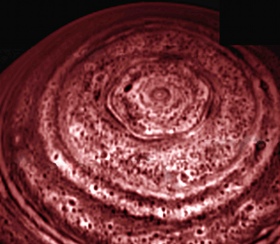 This six-sided feature encircling the north pole of Saturn was already observed by the Voyager spacecraft in the early 80th. Cassini was now able to took this shot in infrared light on Oct. 29, 2006, from an average distance of 902,000 km above the cloud tops of Saturn.
This six-sided feature encircling the north pole of Saturn was already observed by the Voyager spacecraft in the early 80th. Cassini was now able to took this shot in infrared light on Oct. 29, 2006, from an average distance of 902,000 km above the cloud tops of Saturn.
(picture by NASA)
![[Top]](/images/icons/top.gif)
Timetable
| Event |
Date |
Altitude |
| Launch |
15-Oct-97, 08:43 UT |
|
| Venus-1 Flyby |
26-Apr-98 |
336 km |
| Deep Space Maneuver |
03-Dec-98 |
452 m/s (Magnitude) |
| Venus-2 Flyby |
24-Jun-99 |
623 km |
| Earth Flyby |
18-Aug-99 |
1157 km |
| Jupiter Flyby |
30-Dec-00 |
9.72e6 km = 136 RJ
(1 RJ=71400 km) |
| Saturn Arrival |
01-Jul-04 |
1.8e4 km |
| Huygens probe release |
24-Dec-04 |
|
| Huygens probe descent |
14-Jan-05 |
|
| End of prime mission |
30-Jun-08 |
|
| Cassini Equinox Mission |
01-Jul-08 |
|
![[Top]](/images/icons/top.gif)
